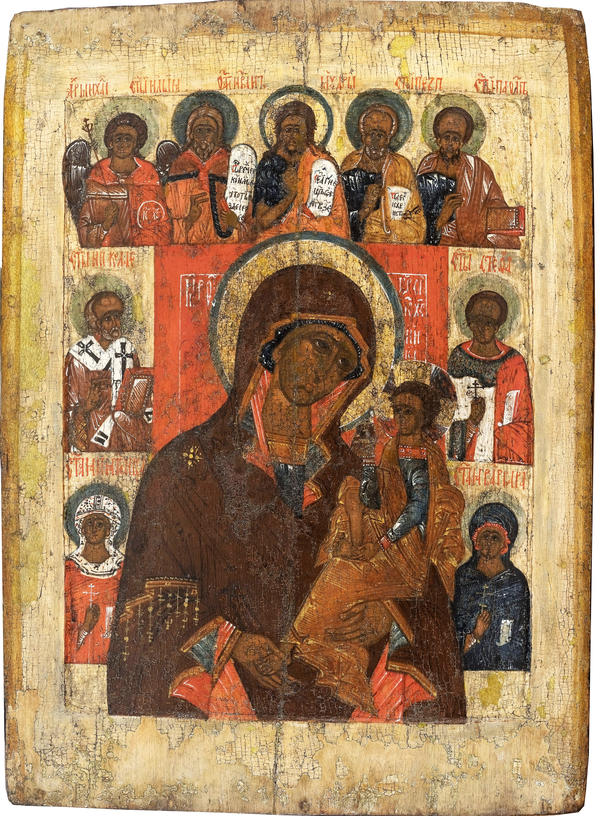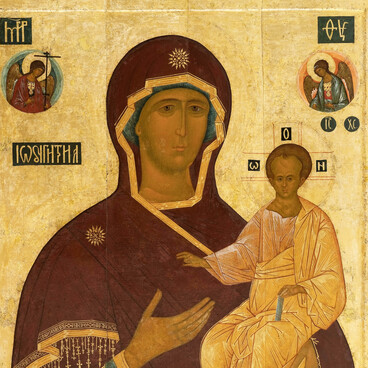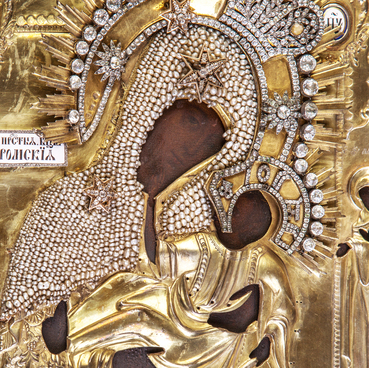The icon Hodigitria and selected saints was created by an unknown icon painter in the middle of the 16th century. The centrepiece of the icon has the image of the Virgin with the Child, the type of which has been known as Our Lady of Shuya since the mid-17th century.
The miraculous icon Our Lady of Shuya was painted in 1654 during a pest. Its creator was a pious resident of the town of Shuya. The icon saved the city from a pestilence.
The Murom icon was in the Assumption Church of Murom. The image of the Virgin with the Baby is surrounded by figures of saints depicted waist-high. These figures of intercessors symbolize the completeness of the Russian Orthodox Church. This type of icons dates back to the traditions of Byzantine art of the 11th – 12th centuries. In Russia, became widespread in the second half of the 15th – first half of the 16th century. As a rule, there were images of the Mother of God with the Baby or St. Nicholas the Wonderworker in the centre of such icons. The figures of the saints were arranged in pairs on the borders of the icon in accordance with the order of holiness or the similarity of veneration.
Above the head of Hodigitria, in the middle of the upper row, there is the figure of St. John the Baptist, who proclaimed the nearing of the Kingdom of Heaven. Above him is placed a unique inscription: ‘Oagios (Saint) Ivan the Sage’, which have not been found in other Russian icons. To his left there is Elijah the Prophet. Those two are not accidentally painted nearby: same as St. John, Elijah was one of the greatest prophets of the Old Testament era, a preacher and ascetic, a pre-image of Christian monks. In Christian tradition, the Fiery Ascension of the Prophet Elijah was perceived as a prototype of the Second Coming and the coming salvation. To the left of St. John the Baptist there is the figure of the Archangel Michael. Like Elijah the Prophet, he was venerated as an intercessor for the souls of the dead. In Russian iconography, the Archangel Michael was often depicted on the icons of the ascension of the Elijah.
Symmetrically to the figures of the Archangel Michael and Elijah there are the images of St. Peter and Paul. In his hands, Peter is holding the key to the gates of Heaven and a scroll with the inscription: You are // Cr // ist. On the side margins, in accordance with the traditional hierarchy of holiness, St. Nicholas the Wonderworker, Archidiaconus Stephen, Martyrs Paraskeva and Barbara are represented.
Archidiaconus Stephen was among the first seven deacons ordained by the Apostles. His image symbolizes the idea the Christian church being apostolic successor. Nicholas the Wonderworker was considered a great hierarch, ‘equal to the Apostles’.
The icon was restored by T. M. Mosunova, a specialist at the Academician I.E. Grabar All-Russia Art Research and Restoration Centre in 1990-1993. Before the restoration, the image on the icon was barely visible since it was covered with a darkened olive oil varnish. A layer of chalk ground was applied in the centre of the icon – a mixture of chalk, linseed oil and animal or fish glue. It hid the difference between the boards and overlapped the image of well preserved personal letter of the Mother of God.
During the works a bright colouring of the icon was revealed. It was built on a combination of cinnabar and yellow arsenic used for painting the background and robes of the saints. Unusually coloured halos of the saints are noteworthy. A wide dark-red panel around the perimeter of the icon preserved the original double light brown framing made by the artist.
The Murom icon was in the Assumption Church of Murom. The image of the Virgin with the Baby is surrounded by figures of saints depicted waist-high. These figures of intercessors symbolize the completeness of the Russian Orthodox Church. This type of icons dates back to the traditions of Byzantine art of the 11th – 12th centuries. In Russia, became widespread in the second half of the 15th – first half of the 16th century. As a rule, there were images of the Mother of God with the Baby or St. Nicholas the Wonderworker in the centre of such icons. The figures of the saints were arranged in pairs on the borders of the icon in accordance with the order of holiness or the similarity of veneration.
Above the head of Hodigitria, in the middle of the upper row, there is the figure of St. John the Baptist, who proclaimed the nearing of the Kingdom of Heaven. Above him is placed a unique inscription: ‘Oagios (Saint) Ivan the Sage’, which have not been found in other Russian icons. To his left there is Elijah the Prophet. Those two are not accidentally painted nearby: same as St. John, Elijah was one of the greatest prophets of the Old Testament era, a preacher and ascetic, a pre-image of Christian monks. In Christian tradition, the Fiery Ascension of the Prophet Elijah was perceived as a prototype of the Second Coming and the coming salvation. To the left of St. John the Baptist there is the figure of the Archangel Michael. Like Elijah the Prophet, he was venerated as an intercessor for the souls of the dead. In Russian iconography, the Archangel Michael was often depicted on the icons of the ascension of the Elijah.
Symmetrically to the figures of the Archangel Michael and Elijah there are the images of St. Peter and Paul. In his hands, Peter is holding the key to the gates of Heaven and a scroll with the inscription: You are // Cr // ist. On the side margins, in accordance with the traditional hierarchy of holiness, St. Nicholas the Wonderworker, Archidiaconus Stephen, Martyrs Paraskeva and Barbara are represented.
Archidiaconus Stephen was among the first seven deacons ordained by the Apostles. His image symbolizes the idea the Christian church being apostolic successor. Nicholas the Wonderworker was considered a great hierarch, ‘equal to the Apostles’.
The icon was restored by T. M. Mosunova, a specialist at the Academician I.E. Grabar All-Russia Art Research and Restoration Centre in 1990-1993. Before the restoration, the image on the icon was barely visible since it was covered with a darkened olive oil varnish. A layer of chalk ground was applied in the centre of the icon – a mixture of chalk, linseed oil and animal or fish glue. It hid the difference between the boards and overlapped the image of well preserved personal letter of the Mother of God.
During the works a bright colouring of the icon was revealed. It was built on a combination of cinnabar and yellow arsenic used for painting the background and robes of the saints. Unusually coloured halos of the saints are noteworthy. A wide dark-red panel around the perimeter of the icon preserved the original double light brown framing made by the artist.




